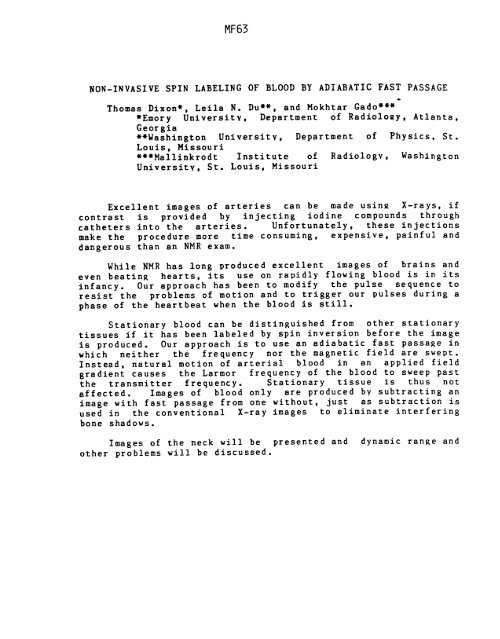th - 1987 - 51st ENC Conference
th - 1987 - 51st ENC Conference
th - 1987 - 51st ENC Conference
Create successful ePaper yourself
Turn your PDF publications into a flip-book with our unique Google optimized e-Paper software.
MF63<br />
NON-INVASIVE SPIN LABELING OF BLOOD BY ADIABATIC FAST PASSAGE<br />
Thomas Dixon ~, Leila N. Du ~, and Mokhtar Gado ~<br />
~Emory University, Department of Radiology, Atlanta,<br />
Georgia<br />
~Washington University, Department of Physics, St.<br />
Louis, Missouri<br />
~Mallinkrodt Institute of Radiology, Washington<br />
University, St. Louis, Missouri<br />
Excellent images of arteries can be made usinm X-rays, if<br />
contrast is provided by injecting iodine compounds <strong>th</strong>rough<br />
ca<strong>th</strong>eters into <strong>th</strong>e arteries. Unfortunately, <strong>th</strong>ese injections<br />
make <strong>th</strong>e procedure more time consuming, expensive, painful and<br />
dangerous <strong>th</strong>an an NMR exam.<br />
While NMR has long produced excellent images of brains and<br />
even beating heartS, its use on rapidly flowing blood is in its<br />
infancy. Our approach has been to modify <strong>th</strong>e pulse sequence to<br />
resist <strong>th</strong>e problems of motion and to trigger our pulses during a<br />
phase of <strong>th</strong>e heartbeat when <strong>th</strong>e blood is still.<br />
Stationary blood can be distinguished from o<strong>th</strong>er stationary<br />
tissues if it has been labeled by spin inversion before <strong>th</strong>e image<br />
is produced. Our approach is to use an adiabatic fast passage in<br />
which nei<strong>th</strong>er <strong>th</strong>e frequency nor <strong>th</strong>e magnetic field are swept.<br />
Instead, natural motion of arterial blood in an applied field<br />
gradient causes <strong>th</strong>e Larmor frequency of <strong>th</strong>e blood to sweep past<br />
<strong>th</strong>e transmitter frequency. Stationary tissue is <strong>th</strong>us not<br />
affected. Images of blood only are produced by subtracting an<br />
image wi<strong>th</strong> fast passage from one wi<strong>th</strong>out, just as subtraction is<br />
used in <strong>th</strong>e conventional X-ray images to eliminate interfering<br />
bone shadows.<br />
Images of <strong>th</strong>e neck will be presented and<br />
o<strong>th</strong>er problems will be discussed.<br />
dynamic range and













